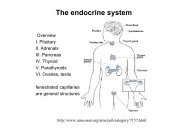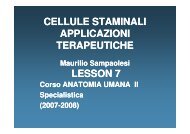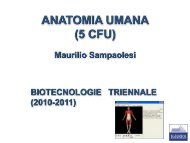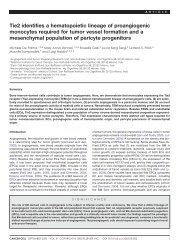HematopoieticSC 25Oct2011 [modalità compatibilità].pdf - HUMAN ...
HematopoieticSC 25Oct2011 [modalità compatibilità].pdf - HUMAN ...
HematopoieticSC 25Oct2011 [modalità compatibilità].pdf - HUMAN ...
You also want an ePaper? Increase the reach of your titles
YUMPU automatically turns print PDFs into web optimized ePapers that Google loves.
CELLULE STAMINALI<br />
APPLICAZIONI<br />
TERAPEUTICHE<br />
Maurilio Sampaolesi<br />
LESSON 8<br />
Corso ANATOMIA UMANA II<br />
Specialistica<br />
(2011 (2011-2012) 2012)
cellule staminali<br />
ematopoietiche:<br />
terapia cellulare<br />
SCRI
• <strong>HUMAN</strong> ANATOMY II -<br />
LESSONS- PAVIA BIOTECHNOLOGY<br />
http://paviabiotechonology.myblog.it/
TESSUTO CONNETTIVO
CELLULE STAMINALI EMATOPOIETICHE
CELLULE STAMINALI EMATOPOIETICHE<br />
terapia cellulare ortodossa<br />
-sostituzione sostituzione di cellule ematopoietiche difettose o malate<br />
(es. ADA ADA-SCID) SCID) con cellule da donatore (terapia (terapia eterologa) eterologa) o<br />
cellule del panziente corrette geneticamente (terapia<br />
autologa)<br />
- LINFOMI (tumori linfocitari)<br />
terapia cellulare non non-ortodossa ortodossa<br />
-utilizzo utilizzo di HSC per altri tessuti effetto diretto<br />
transdifferenziativo ed effetto autocrino autocrino-paracrino paracrino<br />
(angiogenesi, fattori di crescita, fattori antiapoptotici,<br />
immunosoppressivi, antiinfiammatori)<br />
-patologie patologie cardiache (clinical trials!!!)<br />
-patologie patologie muscolari<br />
-altre altre patologie
Ematopoiesi embrionale<br />
• Primitiva Primitiva-- --<br />
– Extra Extra-embryonale<br />
embryonale-nello nello yolk sac<br />
– Definizione: early site of first erythrocytes in<br />
the developing embryo. These cells can only<br />
develop into the erythroid cell not other blood<br />
cell lineages. Primitive red blood cells are<br />
larger than mature red cells of the definitive<br />
lineage, remain nucleated and express a<br />
unique set of hemaglobins.
Isole del sangue del sacco<br />
• Yolk sac is a bilayer<br />
organ composed of<br />
extraembryonic<br />
mesoderm and<br />
visceral endoderm.<br />
• Yolk sac is important<br />
in the processing of<br />
maternal macro-<br />
molecules and<br />
development of first<br />
RBC.<br />
vitellino
Hemangioblasts<br />
(emangioblasta)<br />
• Progenitore teorico comune che può<br />
differenziare sia in cellula<br />
ematopoietica che endoteliale<br />
• Characteristiche<br />
– Espressione di Flk Flk-1 1 (VEGF Receptor),<br />
kit-1 kit 1 (stem cell factor receptor)<br />
– Altri marcatori di progenitori<br />
ematopoietici
Primitive Red Blood Cells<br />
• Soon after their development<br />
of the primitive vasculature of<br />
the embryo proper primitive<br />
red blood cells are seen.<br />
• These cells continue to divide<br />
in the blood stream,<br />
• contain 4 times as much<br />
hemoglobin as adult cells<br />
• There is continued<br />
differentiation that results in<br />
an enucleated cell similar to<br />
adult cells.
Ruolo dei fattori di crescita<br />
nel’eritropoiesi primitiva<br />
• Erythropoietin<br />
Erythropoietin-- -- growth factor associated with adult red<br />
blood cell development has been implicated in primitive<br />
RBC development.<br />
• Role is still controversial but most recent data suggest and<br />
involvement. Erythropoietin increases hemoglobin<br />
production<br />
• mRNA transcripts or receptor have been observed.<br />
• However, in a erythropoietin knockout system there are still<br />
some hemoglobin producing cells of this lineage so not<br />
totally dependent as the fetal liver system is.
EMATOPOIESI DEFINITIVA<br />
-Yolk Yolk Sac<br />
• Developmental cells that can give rise to the complete set of<br />
hematopoietic cells. Thought to be a distinct developmental event from<br />
primitive hematopoiesis<br />
• Initiates in yolk sac and continues in the embryo proper.<br />
• BFU BFU-E E and CFU-E CFU E originate in yolk sac ( (mouse mouse E8.5 and 9.5 respectively<br />
respectively)<br />
• Theses cells then migrate into the newly formed embryo where they fully<br />
differentiate.<br />
• Macrophage precursors are also found in early development in the yolk<br />
sac again suggesting definitive definitive hematopoiesis in the yolk sac.<br />
BFU BFU-E E = Burst-Forming Burst Forming cell Unit Unit-Erythrocytes<br />
Erythrocytes<br />
(unità di formazione esplosiva di colonie eritrocitarie)<br />
in vitro circa 5000 cell/colonia in presenza di IL3; insens. EPO<br />
CFU CFU-E E = Colony formation Unit- Unit Erythrocytes<br />
(unità di formazione di colonie eritrocitarie<br />
in vitro circa 60 cell/colonia in presenza di EPO
EMATOPOIESI DEFINITIVA<br />
- in Embryo Proper<br />
• Definitive hematopoiesis<br />
hematopoiesis-generation generation of more complex (lymphoidmyeloid<br />
myeloid-erythroid) erythroid) progenitors and adult repopulating hematopoietic<br />
stem cells.<br />
• Site Site-paraaortic paraaortic splanchnopleura (PAS) and aorta-gonad<br />
aorta gonad-mesonephros<br />
mesonephros<br />
(AGM) region<br />
• Primary site of fetal hematopoiesis is the liver<br />
• Key to understanding the development of the HSC is understanding<br />
the unique microenvironment of each of the sites(Growth factors, cell-<br />
cell contacts)<br />
• Hematopoietic Stem Cells (HSC) are pluripotent cells that can develop<br />
into all blood cell lineages and other (??) cell types.
Runx1 and AGM<br />
Hematopoietic Development<br />
• Transcription factor associated<br />
with maintenance of HSC<br />
• Knockout models lose fetal<br />
blood development not yolk sac<br />
• Appears in the hematopoietic<br />
islands of the AGM during first<br />
definitive blood production in the<br />
embryo proper
Adult Hematopoiesis
Lymphoid Development
Maintenance of Stem Cell Populations<br />
Role of Bone Marrow Environment and Stromal Cells
Role of Stromal Cells in<br />
Hematopoiesis
Steps in Erythropoiesis<br />
Self renewal vs differentiation<br />
1.Pluripotent stem cells<br />
2. Multipotent progenitors<br />
3. Committed progenitors<br />
4. Progressively maturing<br />
precursors
Concentration of Epo modulates<br />
growth and apoptosis of erythroblasts
CELLULE STAMINALI EMOPOIETICHE<br />
(HSC)
Composizione del sangue<br />
• Plasma: 55 %<br />
• Parte corpuscolata: 45 %<br />
– Globuli rossi 4.5 x 106 – Globuli rossi 4.5 x 10 /µl<br />
– Globuli bianchi 9.0 x 10 3 /µl<br />
– Piastrine 2.5 x 10 5 /µl<br />
• Proteine plasmatiche: prealbumina,<br />
albumina, fibrinogeno, globuline
IRRADIAZIONE X LO STUDIO DI CELLULE STAMINALI
SITI DI EMATOPOIESI NEI MAMMIFERI<br />
(AGM) aorta aorta-gonad gonad-mesonephros mesonephros region
CD34 positive nella aorta dorsale di embrione umano
HSC nel fegato del feto murino
FREQUENZA di HSC
COME VIENE MANTENUTO IL NUMERO<br />
DI CELLULE STAMINALI ?<br />
DIVISIONE ASIMMETRICA<br />
DIVISIONE SIMMETRICA
LA FREQUENZA DI CELLULE STAMINALI E’<br />
CONTROLLATA GENETICAMENTE
LA TELOMERASI E’ RICHIESTA PER EVITARE<br />
L’ACCORCIAMENTO DEI TELOMERI DURANTE<br />
LA DIVISIONE DELLE HSC NEI TRAPIANTI SERIALI
ESISTE UN PROGRAMMA GENETICO PER<br />
DEFINIRE LE CELLULE STAMINALI?
ISOLAMENTO E TRASDUZIONE DELLE HSC
PUO’ UNA CELLULA STAMINALE PLURIPOTENTE<br />
ESSERE TOTIPOTENTE?
“TRANSDIFFERENZIAMENTO DA UNA SINGOLA HSC”<br />
PARABIOSI SPERIMENTALE
Il trapianto di midollo osseo sembrò quindi una<br />
nuova possibile terapia per le distrofie muscolari<br />
E infatti un anno dopo:<br />
Ragioni per il fallimento del trapianto<br />
Ma in realtà meno dell’ 1% delle<br />
fibre muscolari viene “curato”<br />
1. Il topo mdx sviluppa una malattia meno grave della distrofia di Duchenne<br />
2. Le cellule che formano muscolo non hanno problemi senza la distrofina<br />
3. Il tessuto connettivo che si accumula costituisce una barriera per cellule derivate<br />
dal circolo<br />
4. La micro micro-circolazione circolazione del muscolo scheletrico è anche ridotta nelle distrofie<br />
muscolari<br />
5. I progenitori miogenici circolanti o associati ai vasi potrebbero essersi evoluti per<br />
l’accrescimento perinatale dei tessuti più che per la loro rigenerazione<br />
SCRI
A volte le cose vanno meglio<br />
Purified Purified hematopoietic stem cells can differentiate into hepatocytes<br />
in vivo<br />
Lagasse et al. Nature Medicine 6, 1129, 2000<br />
Cellule staminali emopoietiche da topi Rosa 26 formano nuovi<br />
lobuli epatici (blu) quando iniettate nella vena porta di un topo<br />
FAH FAH-/- che manca di un enzima del fegato e va incontro a necrosi<br />
epatica quando privato di un farmaco. In questo caso le cellule<br />
donatrici hanno un immediato vantaggio selettivo rispetto alle<br />
cellule residenti.<br />
SCRI
SCRI
SCRI
SCRI
SCRI
SCRI
Donatori nel Mondo P.M.P. – Anno 2002<br />
North<br />
America (1)<br />
20,7<br />
Central<br />
America (3)<br />
7,9<br />
Caribbean (2)<br />
South<br />
America (4)<br />
2,6<br />
19,9<br />
Europe (5)<br />
Asia (6)<br />
15,9 1,1<br />
South<br />
Africa<br />
2,6<br />
Australia<br />
10,4<br />
perioperative multicomponent pheresis (PMP). PMP is a technique<br />
whereby whole blood is separated into packed red blood cells,<br />
plasma, and platelets<br />
Fonte: International Registry – Transplant Procurement Mangement
Donatori in Europa P.M.P. – Anno 2002<br />
SPAGNA __________ 33,7<br />
AUSTRIA __________ 24,3<br />
BELGIO ___________ 21,7<br />
PORTOGALLO _____ 21,7<br />
FRANCIA __________ 20,0<br />
ITALIA _________ 18,0*<br />
FINLANDIA ________ 17,0<br />
NORVEGIA ________ 13,7<br />
UK________________ 13,0<br />
DANIMARCA ______ 12,7<br />
POLONIA _________ 12,7<br />
OLANDA __________ 12,6<br />
GERMANIA ________ 12,2<br />
SVEZIA ___________ 11,1<br />
SVIZZERA_________ 10,4
21,1<br />
8,8<br />
Abruzzo - Molise<br />
3,4<br />
14,5<br />
Basilicata<br />
7,0<br />
Attività donazione per regione – Anno 2003*<br />
11,2<br />
Calabria<br />
7,4<br />
8,5<br />
Campania<br />
30,8<br />
34,3<br />
Emilia Romagna<br />
18,6<br />
17,5<br />
Friuli Venezia Giulia<br />
Donatori Donatori Utilizzati Utilizzati –– P.M.P. P.M.P.<br />
12,1<br />
9,7<br />
Lazio<br />
21,1<br />
26,5<br />
Liguria<br />
19,6<br />
17,2<br />
Lombardia<br />
13,7<br />
22,3<br />
Marche<br />
22,2<br />
Piemonte - Valle d'Aosta<br />
20,5<br />
39,1<br />
26,2<br />
Prov. Auton. Bolzano<br />
12,6<br />
7,2<br />
10,5<br />
9,5<br />
10,0<br />
12,9<br />
Prov. Auton. Trento<br />
Puglia<br />
Sardegna<br />
Anno 2002 Anno 2003*<br />
7,6<br />
6,4<br />
Sicilia<br />
23,7<br />
22,9<br />
17,2<br />
21,1<br />
24,9<br />
23,4<br />
Toscana<br />
Umbria<br />
Veneto<br />
* Proiezione annuale su dati del 31 luglio 2003
3.667<br />
Attività Attività trapianto di cellule staminali emopoietiche<br />
Totale trapianti<br />
4.245<br />
3.898<br />
2001 2002 2003*<br />
2.632<br />
Autologo<br />
3.077<br />
2.786<br />
2001 2002 2003*<br />
1.025<br />
Allogenico<br />
1.168<br />
1.112<br />
2001 2002 2003*
Trapianto di cellule cellule staminali emopoietiche in Europa<br />
2003<br />
3.898<br />
3.499<br />
3.195<br />
Italy *<br />
Germany<br />
France<br />
2.104<br />
1.889<br />
United Kingdom<br />
Spain<br />
FONTE: EBMT Activity survey 2001: A. Gratwohl, H. Baldomero, Basel, Switzerland<br />
577<br />
573<br />
527<br />
443<br />
429<br />
373<br />
368<br />
317<br />
281<br />
277<br />
223<br />
184<br />
166<br />
166<br />
138<br />
132<br />
127<br />
107<br />
100<br />
92<br />
63<br />
37<br />
27<br />
20<br />
13<br />
12<br />
12<br />
11<br />
9<br />
4<br />
Poland<br />
Netherlands<br />
Belgium<br />
Czech Republic<br />
Sweden<br />
Turkey<br />
Israel<br />
Austria<br />
Switzerland<br />
Finland<br />
Portugal<br />
Greece<br />
Iran<br />
Russia<br />
Denmark<br />
Hungary<br />
Norway<br />
Slovakia<br />
Croatia<br />
Ireland<br />
Republic of Belarus<br />
Ukraine<br />
Slovenia<br />
Serbia and Montenegro<br />
Lithuania<br />
Bulgaria<br />
Estonia<br />
Cyprus<br />
Macedonia<br />
Rumania


![HematopoieticSC 25Oct2011 [modalità compatibilità].pdf - HUMAN ...](https://img.yumpu.com/19234666/1/500x640/hematopoieticsc-25oct2011-modalita-compatibilitapdf-human-.jpg)





